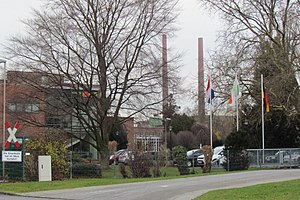Oberbruch oil and paper mill
| Oberbruch oil and paper mill
|
||
|---|---|---|
|
Once the location of the mill, today the Oberbruch industrial park (IPO) |
||
| Location and history | ||
|
|
||
| Coordinates | 51 ° 3 '24 " N , 6 ° 8' 32" E | |
| Location | Germany | |
| Waters | worm | |
| Built | 1797 | |
| Shut down | 1888 | |
| technology | ||
| use | Oil and paper mill | |
| Grinder | 1 grind 1 oil press | |
| drive | 2 water wheels | |
| water wheel | undershot | |
The Oberbruch oil and paper mill was a water mill with two undershot water wheels on the Wurm in the town of Heinsberg in the North Rhine-Westphalian district of Heinsberg in the administrative district of Cologne .
geography
The oil and paper mill Oberbruch had its location on the worm at the Boos Fremery street, in the district of Upper break in the town of Heinsberg. The property on which the mill building stood is approx. 42 m above sea level . Above was the Porselener Mühle , below the Unterbrucher Mühle .
Waters
The worm supplied numerous mills with water over a river length of 53 km. The source of the worm is south of Aachen at 265 m above sea level. The confluence with the Rur is in the town of Kempen in the town of Heinsberg at 32 m above sea level. In the late 1960s and early 1970s, worm straightening was carried out. The curving, now and then meandering course of the river disappeared in favor of a simple route . The river length shortened and the flow speed increased. For many people the flood protection improved , for the mills it was the end. The water association Eifel-Rur (WVER) is responsible for the care and maintenance of the water body with a catchment area of 355.518 km 2 .
history
With the French occupation in 1800 moved to the native climes also a certain freedom of trade one. This had the consequence for the mill system that several mills were rebuilt around this time. This resulted in four successive worm mills over a distance of less than 10 km. These were the Porselener Mühle, Oberbruch oil and paper mill, Unterbrucher Mühle and the Lohmühle .
The Oberbruch oil and paper mill was built in 1797 by the businessman Andreas Josef Berens. In the mill, which was driven by two water wheels, he produced flower and oil paper for wrapping steel goods . When the water quality deteriorated due to increasing industrial pollution , he sold the mill in 1864 and moved production to the Rischmühle in Brachelen . In Oberbruch they limited themselves to the production of cardboard . In 1888 the mill was shut down.
The mill building and the site have now been used for other purposes. The production of incandescent lamps began in 1891 . The entrepreneur Dr. Max Fremery and the engineer Johann Urban tried to develop better and more resilient filaments for their light bulbs. In doing so, they discovered a manufacturing process for the production of rayon . They switched operations to this at the turn of the century , thus laying the foundation for the world-famous Glanzstoffwerke Oberbruch .
gallery
Where the mill once stood is now the Oberbruch industrial park (IPO)
Oil and paper mill Oberbruch on the tranchot card 1805/1807
literature
- Hans Vogt: Lower Rhine water mill guide 2nd edition. Verein Niederrhein, Krefeld 1998, ISBN 3-00-002906-0 , pages 294-295.
- Susanne Schwab: Oberbrucher incandescent lamps light the way for the textile fiber industry. Home calendar of the Heinsberg district, 1989, pages 168–172
→ See also the list of mills on the Wurm
Web links
Individual evidence
- ^ German basic map 1: 5000
- ↑ Topographical Information Management, Cologne District Government, Department GEObasis NRW ( Notes )
- ↑ Archive link ( Memento from October 17, 2013 in the Internet Archive )
- ↑ http://www.wver.de/






